Child Mortality Estimation: Estimating Sex Differences in Childhood Mortality since the 1970s
Introduction:
Producing estimates of infant (under age 1 y), child (age 1–4 y), and under-five (under age 5 y) mortality rates disaggregated by sex is complicated by problems with data quality and availability. Interpretation of sex differences requires nuanced analysis: girls have a biological advantage against many causes of death that may be eroded if they are disadvantaged in access to resources. Earlier studies found that girls in some regions were not experiencing the survival advantage expected at given levels of mortality. In this paper I generate new estimates of sex differences for the 1970s to the 2000s.
Methods and Findings:
Simple fitting methods were applied to male-to-female ratios of infant and under-five mortality rates from vital registration, surveys, and censuses. The sex ratio estimates were used to disaggregate published series of both-sexes mortality rates that were based on a larger number of sources. In many developing countries, I found that sex ratios of mortality have changed in the same direction as historically occurred in developed countries, but typically had a lower degree of female advantage for a given level of mortality. Regional average sex ratios weighted by numbers of births were found to be highly influenced by China and India, the only countries where both infant mortality and overall under-five mortality were estimated to be higher for girls than for boys in the 2000s. For the less developed regions (comprising Africa, Asia excluding Japan, Latin America/Caribbean, and Oceania excluding Australia and New Zealand), on average, boys' under-five mortality in the 2000s was about 2% higher than girls'. A number of countries were found to still experience higher mortality for girls than boys in the 1–4-y age group, with concentrations in southern Asia, northern Africa/western Asia, and western Africa. In the more developed regions (comprising Europe, northern America, Japan, Australia, and New Zealand), I found that the sex ratio of infant mortality peaked in the 1970s or 1980s and declined thereafter.
Conclusions:
The methods developed here pinpoint regions and countries where sex differences in mortality merit closer examination to ensure that both sexes are sharing equally in access to health resources. Further study of the distribution of causes of death in different settings will aid the interpretation of differences in survival for boys and girls.
Please see later in the article for the Editors' Summary.
Published in the journal:
. PLoS Med 9(8): e32767. doi:10.1371/journal.pmed.1001287
Category:
Research Article
doi:
https://doi.org/10.1371/journal.pmed.1001287
Summary
Introduction:
Producing estimates of infant (under age 1 y), child (age 1–4 y), and under-five (under age 5 y) mortality rates disaggregated by sex is complicated by problems with data quality and availability. Interpretation of sex differences requires nuanced analysis: girls have a biological advantage against many causes of death that may be eroded if they are disadvantaged in access to resources. Earlier studies found that girls in some regions were not experiencing the survival advantage expected at given levels of mortality. In this paper I generate new estimates of sex differences for the 1970s to the 2000s.
Methods and Findings:
Simple fitting methods were applied to male-to-female ratios of infant and under-five mortality rates from vital registration, surveys, and censuses. The sex ratio estimates were used to disaggregate published series of both-sexes mortality rates that were based on a larger number of sources. In many developing countries, I found that sex ratios of mortality have changed in the same direction as historically occurred in developed countries, but typically had a lower degree of female advantage for a given level of mortality. Regional average sex ratios weighted by numbers of births were found to be highly influenced by China and India, the only countries where both infant mortality and overall under-five mortality were estimated to be higher for girls than for boys in the 2000s. For the less developed regions (comprising Africa, Asia excluding Japan, Latin America/Caribbean, and Oceania excluding Australia and New Zealand), on average, boys' under-five mortality in the 2000s was about 2% higher than girls'. A number of countries were found to still experience higher mortality for girls than boys in the 1–4-y age group, with concentrations in southern Asia, northern Africa/western Asia, and western Africa. In the more developed regions (comprising Europe, northern America, Japan, Australia, and New Zealand), I found that the sex ratio of infant mortality peaked in the 1970s or 1980s and declined thereafter.
Conclusions:
The methods developed here pinpoint regions and countries where sex differences in mortality merit closer examination to ensure that both sexes are sharing equally in access to health resources. Further study of the distribution of causes of death in different settings will aid the interpretation of differences in survival for boys and girls.
Please see later in the article for the Editors' Summary.
Introduction
Sex is a key variable for disaggregation of childhood mortality rate estimates, both for monitoring and analytical purposes and as an input to other demographic estimates such as sex-specific life tables or population size and structure. However, the task of estimating trends in sex-specific child mortality, particularly for countries without reliable death registration statistics, is far from straightforward, and sex-specific data are frequently more limited or noisier than those available for both sexes combined. In this paper I outline the challenges in the estimation and interpretation of sex-specific childhood mortality rates, and develop simple methods to take advantage of available data on under-five or infant mortality by sex. The analysis updates previous United Nations work on sex differences in childhood mortality [1],[2].
Challenges in the Estimation of Mortality Trends Disaggregated by Sex
Reliably estimating even overall trends in childhood mortality—that is, without taking into account differences by sex—is a difficult task in many developing countries. In the absence of complete and reliable vital registration systems in much of the developing world, estimation of mortality rates for children primarily relies upon data from certain questions in household sample surveys and population censuses [3]. These questions elicit information from female respondents about their childbearing history, either in detail or in summary, and the survival status of their children. Estimates based on these questions are subject to sampling errors (for surveys) and non-sampling errors (for both surveys and censuses), with the outcome that multiple inquiries may produce quite different estimates for the same time period. Since 2004, the United Nations Inter-agency Group for Child Mortality Estimation (UN IGME) has reconciled inconsistent data on overall (both-sexes) under-five mortality for each country using regression models to produce a best estimate of trends from the 1960s to the present [3]. The UN IGME also produces time series of infant mortality estimates.
One reason that the UN IGME has not taken sex-specific data into account to date is that some of the censuses and surveys on which United Nations estimates of both-sexes mortality are based did not collect the relevant data by sex. If estimates by sex were to be produced by fitting trend lines to sex-specific data, the estimates might not be consistent with estimates for both sexes combined that incorporate more data sources. A further complicating factor is that sampling error for mortality estimates from surveys—which is often large already for both sexes combined due to the relatively small number of child deaths even in a large sample—is increased when mortality estimates are disaggregated by sex or any other variable.
For countries with high-quality data from vital registration, computing mortality rates by sex from annual data is uncomplicated, but there is a further consideration pertaining to the analysis of sex differentials in mortality. In countries with low levels of mortality, ratios of male to female under-five and infant mortality can fluctuate substantially from year to year because of small numbers of deaths. For purposes of analysis and cross-national comparisons, some form of smoothing is desirable.
Interpreting Sex Differentials in Childhood Mortality
Boys and girls have different probabilities of death due to biological factors, and these differences vary between infancy and early childhood. If sex-disaggregated estimates are to be used for monitoring or advocacy purposes, it must be clearly explained to users (1) what the expected differences are, (2) when a given difference might indicate excessive disadvantage for one sex or the other, and (3) how to understand changes.
The under-five mortality rate, also denoted in the literature as U5MR or 5q0, is the probability of dying between birth and exact age 5 y. The components of the under-five mortality rate examined here are the infant mortality rate (the probability of dying between birth and exact age 1 y, denoted 1q0) and the child mortality rate (the probability of dying between exact ages 1 and 5 y, denoted as 4q1). The under-five mortality rate and its components are related as follows:
The measures of sex differences employed are the ratios of male to female rates of infant, child, and under-five mortality, multiplied by 100 for ease of presentation.Equity in survival between females and males does not imply equal mortality rates (that is, male-to-female ratios equal to 100). Under circumstances where boys and girls have the same access to resources such as food and medical care, boys have higher mortality rates than girls during childhood, and the examined ratios would overall be expected to be greater than 100. Newborn girls have a biological advantage in survival over newborn boys, with lesser vulnerability to perinatal conditions (including birth trauma, intrauterine hypoxia and birth asphyxia, prematurity, respiratory distress syndrome, and neonatal tetanus), congenital anomalies, and such infectious diseases as intestinal infections and lower respiratory infections [4]. However, beyond early infancy, girls do not enjoy the same advantage in relation to certain infectious diseases, which are the primary causes of death in later infancy and early childhood in settings where overall mortality is high [5],[6]. Thus, the sex ratio of child mortality (that is, mortality at ages 1–4 y) is generally lower than the sex ratio of infant mortality (Figure 1). The sex ratio of under-five mortality is intermediate between the two, and will depend on the relative mortality levels of the infant and child age groups.
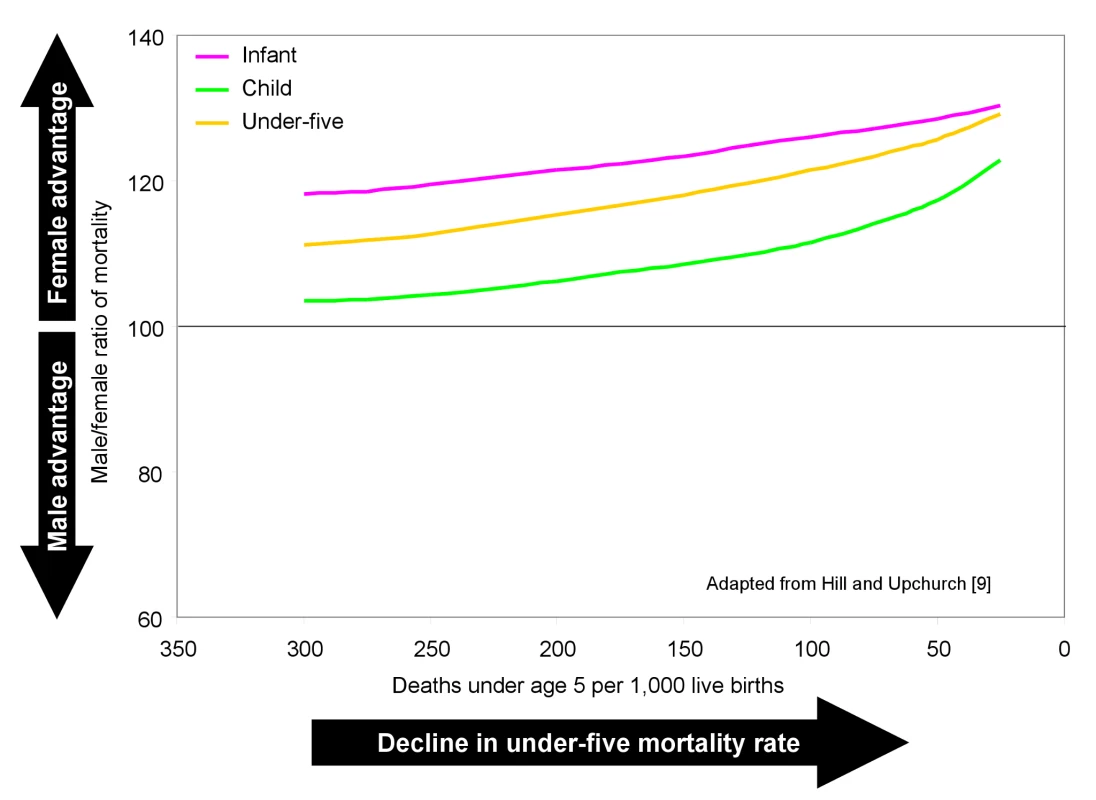
As living conditions improve, an “epidemiological transition” occurs during which infectious diseases recede as a cause of death [7]. As the decline in infectious disease proceeds, perinatal and congenital causes form an increasing share of total mortality among infants, while external causes, more typically affecting boys, form an increasing share of mortality for children between ages 1 and 5 y [8],[9]. Hence, as overall levels of mortality fall, female advantage in infant and child mortality would normally increase, assuming no sex-specific changes in the treatment of children. Figure 1 shows the historical change in sex ratios of infant, child, and under-five mortality for several developed countries where access of children to resources was not believed to differ greatly by sex [9]. The female advantage in survival, however, can be eroded if girls are deprived relative to boys in access to health care or to proper nutrition. If such deprivation occurs, the sex ratio of mortality might be substantially below the values shown in Figure 1 for a given level of mortality.
Because of the biologically based characteristics of differential survival by sex, it is difficult to construct a precise target of gender equity in survival in childhood. However, situations in which the survival of girls is lower than that of boys—that is, the sex ratio of mortality is less than 100—suggest that differential treatment or access to resources may be putting girls at a disadvantage. Earlier studies have found numerous countries in many regions of the world, particularly southern Asia, eastern Asia, and northern Africa/western Asia, where mortality at ages 1–4 y was higher for girls than for boys [1],[10],[11]. India and China in particular have a long-documented history of female disadvantage in mortality that is covered in an extensive literature [12]–[25].
The present study addresses the challenges outlined above in the estimation and interpretation of sex differentials. I estimate smoothed trends in the sex ratio of mortality for infants and young children to evaluate changes over time in the relative mortality of males and females for individual countries and world regions. I also examine regional differences in the relationship between the overall level of under-five mortality and sex ratios of infant and child mortality.
Methods
Data Sources
The three indicators of childhood mortality can be estimated directly or indirectly from demographic data sources. Direct estimates of 1q0, 4q1, and 5q0 are calculated from reported deaths and information on the population exposed to the risk of death, and do not require the use of models for their derivation. Direct estimates may be based either on vital events data—normally from a vital registration system or in some cases from information about household deaths collected in a census or large survey—or on survey questions posed to adult women about their childbearing histories. The childbearing histories collected in surveys comprise the date of each live birth and the age at death of children who have died before the survey date. Period-specific probabilities of dying calculated from birth histories are based on reported deaths and the numbers of children at risk of dying during a specific period, such as the 5 y preceding the survey [26].
Indirect estimates of mortality in childhood are derived from summary data on the total number of children ever born and number surviving to women of reproductive age. The method used to derive indirect estimates (also known as the Brass method) is described in detail in a United Nations manual [27]. A large number of censuses and surveys have collected the required data, although the data are not always collected or published by sex (that is, the questionnaires do not always ask about sons and daughters separately, or, if they do, the separate tabulations may not be published). The Brass method translates proportions of children surviving classified by age of mother at the time of data collection into measures of survival to various childhood ages, which in turn can be transformed into standard indicators of childhood mortality using model life tables. Under-five mortality is the preferred indicator derived via the Brass method, because 5q0 is more robust to the choice of model life table than 1q0, which can vary considerably according to the model selected. For this reason, indirect methods do not provide a satisfactory basis for estimating sex ratios of 1q0, since the sex ratios obtained for this indicator through indirect methods are more affected by the choice of mortality model used than are differentials in 5q0.
The dataset used for this study builds upon datasets [28]–[30] that were developed for a 1998 United Nations publication on sex differentials in childhood mortality [1] and expanded for a 2011 report [2] (data collection for [2] was completed in 2010; the present study incorporates additional or revised data obtained through November 2011). Microdatasets from Demographic and Health Surveys (DHS) were processed to produce a time series from each survey of direct estimates of 5-y mortality rates by sex, extending back to a period 20–24 y before each survey. In addition, tabulations of children ever born and children surviving by age of the mother were calculated by sex of the child for each DHS survey to produce indirect estimates of 5q0. An important new source of data since the mid-1990s is the Multiple Indicator Cluster Survey program, conducted by the United Nations Children's Fund, which has yielded additional sets of indirect estimates by sex, many for countries that had very limited data by sex from other sources. For other survey programs (including the World Fertility Survey, the Reproductive Health Survey, and the Pan Arab Project for Family Health), surveys not affiliated with the major survey programs, and censuses, the data used here are any direct or indirect estimates by sex available in published sources, or calculated from tabulations available therein. In addition, the number of data points from vital registration was greatly expanded. A large dataset of infant and under-five mortality by sex calculated from vital registration data was provided by the World Health Organization. These data were supplemented with registration data from the Human Mortality Database, the United Nations Demographic Yearbook, and other sources of life tables.
Table S1 lists the data sources considered for each country.
Data Issues
Vital registration data
Data derived from the complete registration of births and deaths are the ideal basis for the estimation of mortality, since they cover the full set of events of interest and permit the estimation of trends. Unfortunately, in most developing countries the coverage and completeness of registration by vital registration systems is insufficient to produce accurate estimates of the level of childhood mortality. However, in the absence of evidence that reporting of births and deaths differs by sex of the child in a way that would affect the ratio of male to female mortality, such ratios derived from vital registration may usefully inform trends of sex differentials. The sex differentials in 1q0 and 5q0 calculated from vital registration data were used without adjustment, even when overall births and child deaths were known to be under-registered, on the assumption that under-registration in vital registration systems did not differ by sex of the child. More study is required to assess whether this assumption is valid. For most countries, however, sex differentials estimated from vital registration are consistent with those calculated from survey birth history data and often have considerably less variability. The same assumption of sex-neutral underreporting was made for data from census or survey questions on household deaths.
Survey data
Compared to most measures estimated by sample surveys, deaths of children are relatively rare events. The sample sizes of typical household surveys are not large enough to produce very precise estimates of childhood mortality, even for both sexes combined at the national level. In a study of 50 DHS surveys, Curtis [31] showed that relative standard error for estimated infant and under-five mortality over a 5-y period for both sexes at the national level ranged from 0.04 to 0.08, implying that the 95% confidence interval ranged from 8% to 16% on each side of the point estimate. For child mortality, relative standard errors were higher, in the range of 0.06 to 0.15, because fewer deaths occur at ages 1 to 4 y.
Such large sampling errors, which are even larger when estimates are disaggregated for a subset of the sample, complicate the assessment of trends in differential mortality by sex. For example, the male-to-female ratio of infant mortality calculated from birth histories for the Haiti 2000 DHS survey was 141 for 1991–1995 and 93 for 1996–2000, while the corresponding ratios for child mortality were 88 and 105. If taken at face value, the reported ratios would imply that the situation in Haiti changed from one in which there was excess male mortality under age 1 y and excess female mortality between ages 1 and 4 y to a reverse situation in only 5 y. The trend estimates derived in this study smooth out such fluctuations through the application of regression techniques described below.
Some important potential non-sampling biases in survey reports of childbearing histories include errors in the dating of births and deaths or omission of events from the birth history. Incorrect assignment of dates to events—for example, the heaping of date of death on 12 mo of age—can have an effect particularly on the relative levels of 1q0 and 4q1. Fortunately, for the purposes of the present study, such misdating is unlikely to occur differentially for the deaths of boys and girls, so it is unlikely to have a major impact on the sex differentials in either of these indicators. Omission of children from the birth history, on the other hand, might be more likely to differ by sex of the child. In most cases, however, there was insufficient data from alternative sources to assess whether sex-differential omission from survey birth histories was occurring. The exception was in India, where examination of sex ratios of infant mortality (SR1) from the Sample Registration System and from the National Family Health Surveys revealed systematic differences in the sex ratio of infant mortality between the two sources, with SR1 estimates from the National Family Health Surveys being consistently higher than those from the Sample Registration System. For the sex ratio of child mortality, in contrast, the two sources produced consistent estimates. The discrepancy in SR1 could be due either to defects in the sample registration system that understate male mortality, or to omission from the survey birth histories of girls who died, thus inflating survey estimates of excess male mortality. The assessment was made that the difference in SR1 was most likely due to underreporting in the National Family Health Surveys birth histories of babies who died shortly after birth, with daughters who died more likely to be omitted than sons who died [2],[32].
Availability of recent data
A final caveat refers to the availability of data for the 2000s. In many cases, the last available data point refers to 2005 or earlier (Table S1), and the estimates for the latter part of the decade are a projection of the earlier trend.
Estimation Methods
The estimation of sex differentials in under-five, infant, and child mortality proceeded in three basic steps: (1) estimate trend in the sex ratio of 5q0 (SR5); (2) estimate, and adjust if appropriate, trend in the sex ratio of 1q0 (SR1); and (3) apply those trends to both-sexes estimates of 5q0 and 1q0 to derive estimate and sex ratio of 4q1 (SR4).
In the first step, a weighted trend line SR5t was fitted to all available SR5 estimates. The weights for data points from surveys, censuses, and vital registration were determined using a weighting scheme used in previous work by the UN IGME [33],[34]. This weighting scheme assigns progressively lower weights to direct estimates from birth histories that refer to 5-y time periods more distant from the survey date, on the assumption that recall errors may affect distant periods more strongly. For indirect data, low or zero weights are assigned to indirect estimates that are based on reports of women in the early and late childbearing years, on the assumption that these estimates may be of lower quality or subject to systematic biases.
Because of variations between countries in the amount and consistency of data available, three different methods were ultimately employed to estimate sex ratios of mortality. Initially, loess regression was tested for all countries. The loess method fits a series of polynomials to localized subsets of the data centered on each point of the dataset. The weight of each data point in the localized regression is determined by its distance from the center. A bandwidth, denoted alpha, selected by the user, determines the proportion of the dataset used to fit each local regression. A number of different alpha values were tested, to impose varying degrees of smoothing. For countries where estimates were based on a time series of vital registration data, it was found that the loess with an alpha of 0.75 captured changes in trend without being overly sensitive to short-term variation. In addition, a re-descending M estimator with Tukey's biweight function was applied in the loess procedure in R (family = “symmetric”) to reduce the influence of more extreme data points. The case of Bulgaria is shown in Figure 2A to illustrate the loess fitting method.
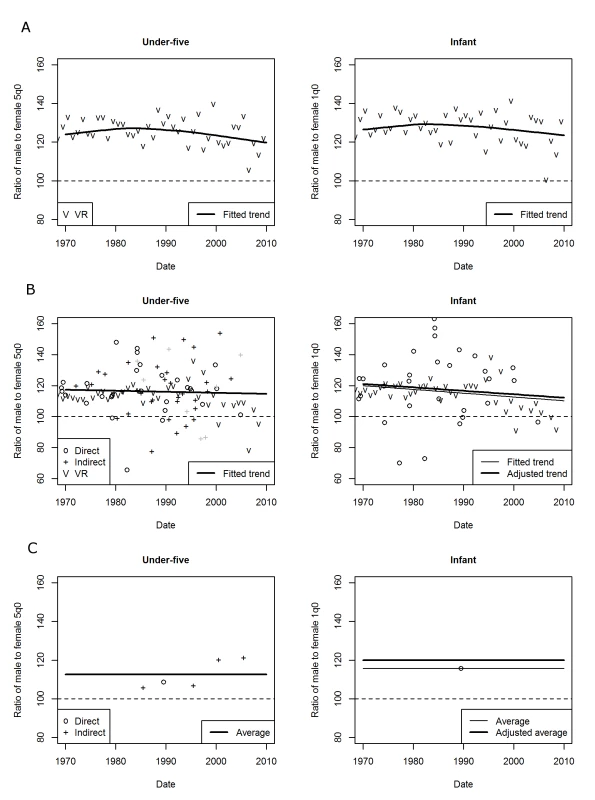
For countries where the primary sources of data were sample surveys, however, the degree of smoothing required to achieve plausible results with the loess often was so strong that the results differed little from a simpler linear regression. The linear regression line had the additional benefit of being more straightforward to adjust for SR1, as described below. Therefore, for many developing countries the results are based on robust linear regression (implemented with the rlm function in the R MASS package and hereafter referred to as the “linear method”), shown for the Dominican Republic in Figure 2B.
There were a number of countries where neither loess nor robust linear regression fitted to all data points was able to produce a result that was satisfactory for purposes of analysis or disaggregation. In a few of these countries, where time series of vital registration data were available to fit a stable trend and survey data had high sampling error, the decision was made to exclude the survey data and fit the loess or robust linear regression to the vital registration data only. In countries where such a stable time series was not available, a simple weighted average of all available SR5 data was computed (as in Figure 2C for Lao People's Democratic Republic). Such an average may be useful for disaggregating both-sexes estimates if no other method is available, but it does not give any information on time trends in SR5. For this reason, results from the average method are not analyzed at length, and countries where it was used are excluded from the time trend analysis for regional aggregations presented below. Table S2 indicates which of the methods—loess, linear, or average—was used to produce estimates of sex differentials for each country.
The second step of the estimation process was to fit a trend line SR1t to available data on SR1. As was noted in the previous section on data sources, indirect data on SR1 were not included in the analysis because SR1 is less robust than SR5 to the choice of model life table. Yet, using only direct data for SR1 while using both direct and indirect data for SR5 could cause inconsistency between time series fitted for SR1 and SR5. This was particularly the case in countries where a number of surveys had collected indirect data only. Therefore, in order to best exploit the available information, direct and indirect estimates of SR5 were used to adjust direct estimates of SR1 in the linear and average methods. A preliminary trend line, SR1t*, was fitted to SR1 from direct data using the same fitting method that had been selected for SR5t. If no indirect data had been used to fit SR5t, then SR1t* was adopted as the final estimate SR1t. If both direct and indirect data had been used to fit SR5t, an additional trend line, SR5t*, was fitted to SR5 points coming from direct data only. The ratio of SR5t/SR5t* was used to adjust SR1t*, producing the final estimate SR1t. Figure 2B and 2C show the results of this adjustment for the Dominican Republic and Lao People's Democratic Republic, respectively.
Predicted SR5t and SR1t were applied to estimates of 5q0 and 1q0 for both sexes to produce time series of infant and under-five mortality levels by sex. Levels of 5q0 by sex for time period t were derived from the both-sexes estimates using the formulas
and where SRB is the sex ratio at birth as estimated for each country for the period 2000–2005 in World Population Prospects: The 2010 Revision [35]. Corresponding formulas were applied for infant mortality. Then, 4q1male and 4q1female were derived via the relationship in Equation 1. The resulting 4q1male and 4q1female were used to compute estimates of SR4t. These derived estimates of SR4t were compared to direct data on SR4 from surveys or vital registration and generally found to be consistent.Estimates of under-five and infant mortality rates for both sexes combined were taken from two United Nations sources, World Population Prospects: The 2010 Revision, produced by the Population Division [35], and Levels & Trends in Child Mortality: Report 2011, produced by the UN IGME [36],[37]. The estimates from these two sources are generally quite similar for 5q0—the indicator coordinated by the UN IGME—but can differ somewhat more for 1q0, usually because of the use of different model life tables. The both-sexes estimates for 5q0 and 1q0 from World Population Prospects [35] were used in this report for most developing countries (noting that for 5q0 the estimates referring to periods prior to 1980 are unpublished). The choice of which series of both-sexes estimates to use does not affect the estimated trends SR5t or SR1t, as those come from the data, but it does affect estimated trends in SR4t because the trend in the sex ratio of 4q1 derived from estimated 5q0 and 1q0 is dependent on the relative levels of 5q0 and 1q0 as well as the sex differentials in each. There were only a few cases where the choice of both-sexes estimate made an appreciable difference in SR4t. For countries of the more developed regions, estimates from Levels & Trends in Child Mortality [36] were used because levels of 5q0 and 1q0 from this set of estimates are taken directly from annual vital registration.
For countries where averages of SR5 and SR1 were employed, these average ratios were applied to the whole series of both-sexes estimates. It should be noted that applying constant SR5t and SR1t to changing both-sexes estimates results in SR4t values that change over time. However, these changes in SR4t should not be interpreted as trends and will not be presented as such. As noted above, estimates for countries where the average method was used are not included in the aggregated trends for regions and development groups presented below.
Estimates were attempted for all countries or areas (hereafter referred to as countries) that had a population of 1 million or more in 2010. Out of the 156 countries with such a population, estimates were generated for 153 countries (Table 1). Of these, 113 were in less developed regions, comprising Africa, Asia excluding Japan, Latin America/Caribbean, and Oceania excluding Australia and New Zealand (the lists of countries located in the less developed regions and more developed regions as well as the other geographical groupings used for this study—sub-Saharan Africa, northern Africa/western Asia, eastern/southeastern Asia, Commonwealth of Independent States [CIS] Asia, Latin America/Caribbean, and developing Oceania—are shown in Table S3). Ninety-two countries in the less developed regions, containing 92% of the population of those regions, had sufficient data to apply the methods developed for trend analysis. For an additional 21 countries, holding 6% of the population of the less developed regions, enough data were available to estimate average sex differentials in under-five or infant mortality, which were assumed to apply to the entire time span under consideration.
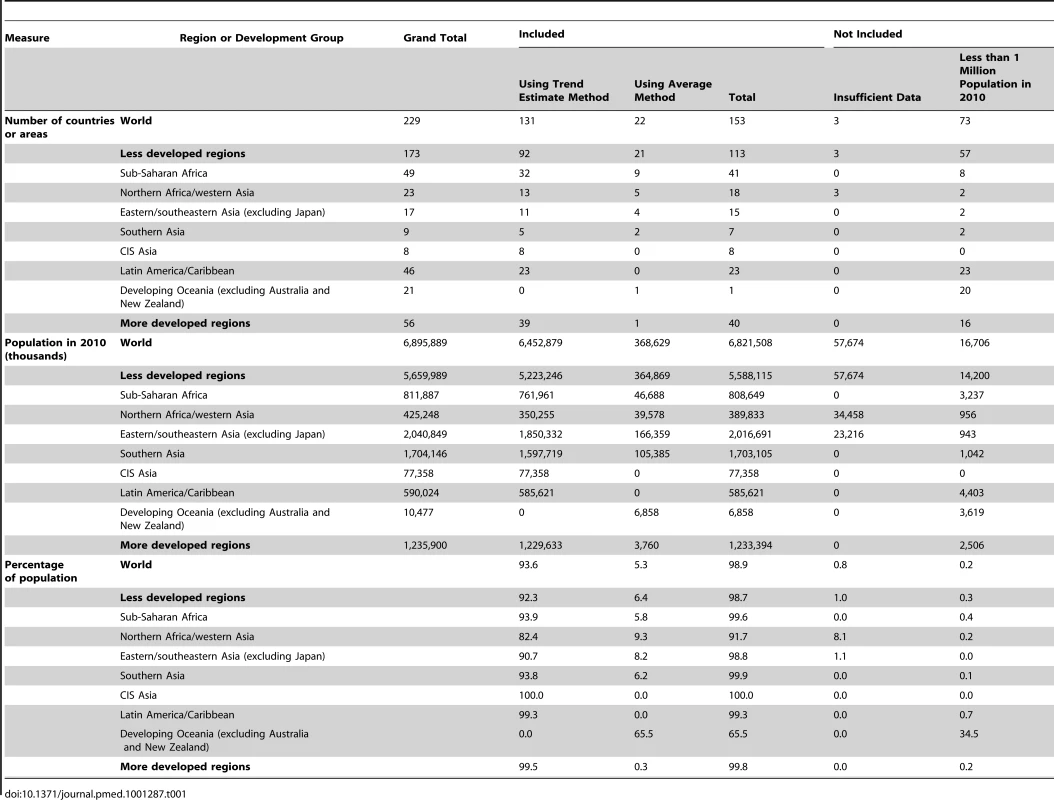
Trends were estimated for 39 countries in the more developed regions (comprising Europe, northern America, Japan, Australia, and New Zealand), while for one developed country (Bosnia and Herzegovina), only average sex differentials could be estimated.
The methods and results presented in this article were developed as an analytical study separate from the production of United Nations mortality estimates published in Levels & Trends in Child Mortality [36] or World Population Prospects [35]. The mortality estimates by sex presented here may differ from estimates in forthcoming editions of those publications due to differences in data availability or other methodological considerations.
Results
Trends in the sex ratios of under-five, infant, and child mortality are summarized as decade averages for the 1970s, 1980s, 1990s, and 2000s. Two different approaches to examining global and regional trends are examined: first, considering each country as a unit of analysis for computing median country-specific ratios (Table 2) and, second, weighting country mortality rates by number of births to produce weighted regional averages (Table 3). The country results on which the regional analyses are based may be found in Table S2. Only the 131 countries for which trend estimates were produced were included in the computation of regional medians and averages.
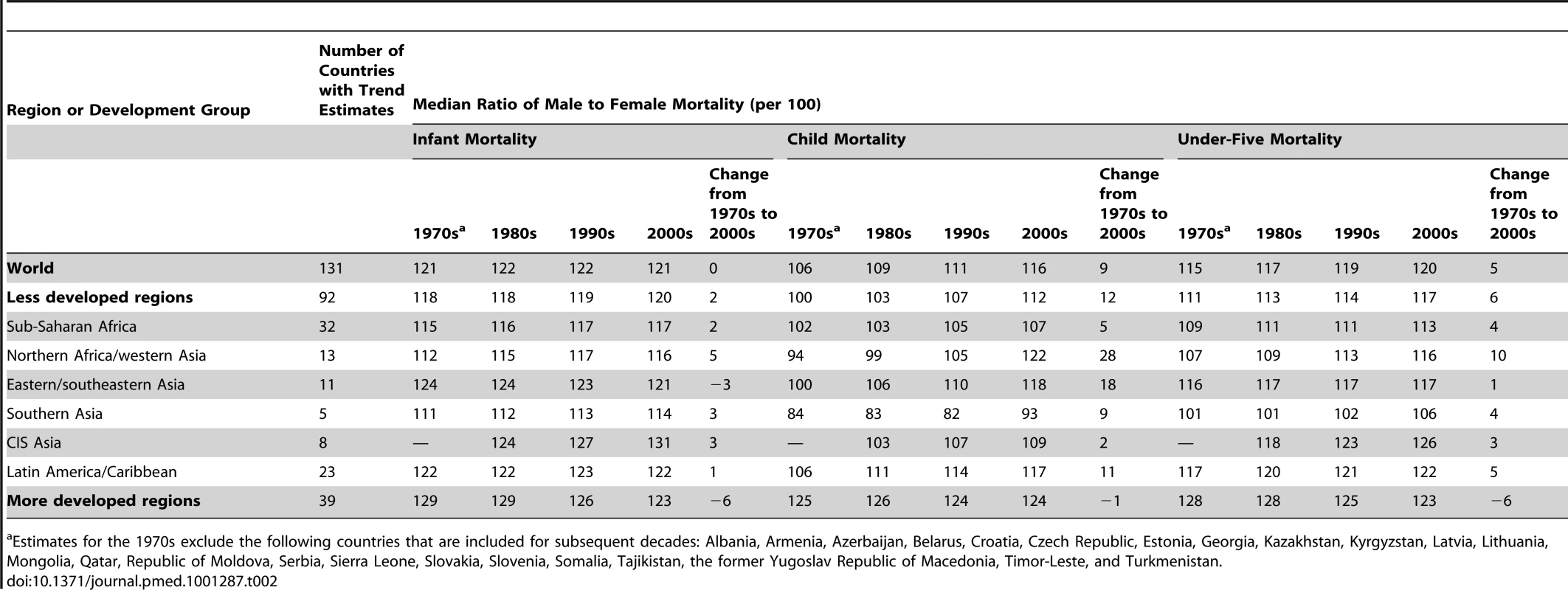
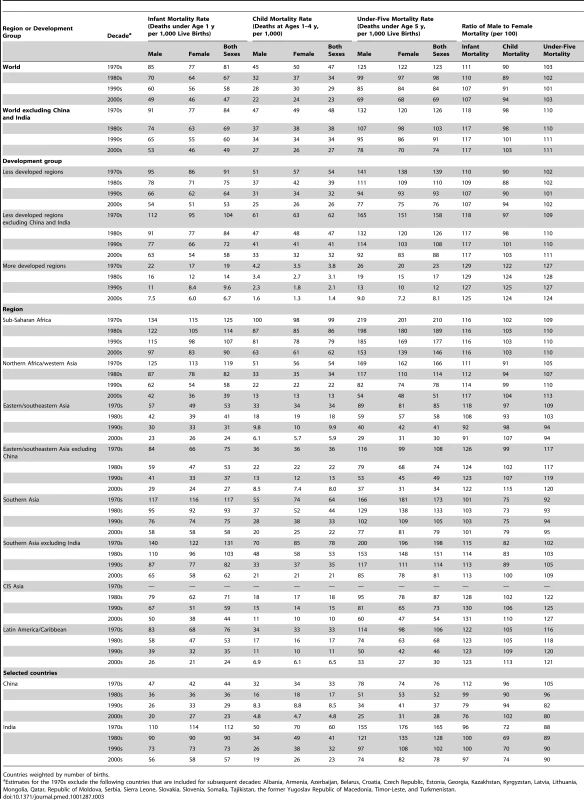
Table 2 shows that in the less developed regions the median sex ratio of under-five mortality increased from the 1970s to the 2000s. For the 92 countries in the less developed regions for which trends were estimated in this study, the median sex ratio of under-five mortality increased from 111 in the 1970s to 117 in the first decade of the 2000s. Thus, in the majority of developing countries, females have an advantage in survival to age 5 y, and this advantage has increased, as expected from the historical experience of developed countries as described above, as mortality has declined. This increase is due primarily to increases in the sex ratio of mortality at ages 1–4 y in many countries, while increases in the sex ratio of the infant component of under-five mortality have been smaller.
However, when countries are weighted according to the number of births, no such rise in the sex ratio of under-five mortality is seen. On average, the sex ratio of under-five mortality in the less developed regions remained nearly constant, around 101 to 102, from the 1970s to the 2000s (Table 3; Figure 3). This difference between the median trend and the birth-weighted trend occurs because the sex ratios of under-five mortality estimated for the two most populous countries, China and India, constitute important exceptions to the rising trend. Estimated sex ratios of under-five mortality for the first decade of the 2000s were below 100 in both countries (Table 3), indicating substantial excess female mortality. In China, the sex ratio of under-five mortality declined between the 1970s and the 2000s, while in India it remained roughly constant, suggesting that even though mortality rates were falling in both countries, girls did not share in survival improvements to the expected extent.
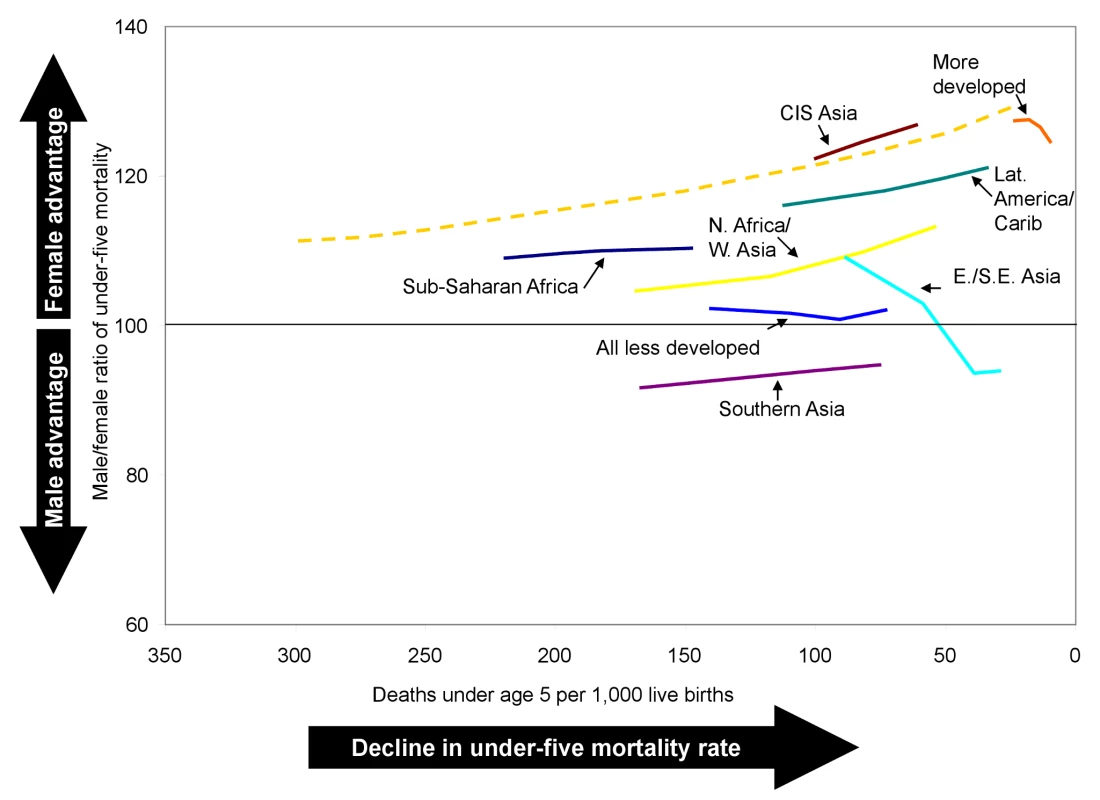
Moreover, China and India were the only two countries in the world where female infant mortality was higher than male infant mortality in the 2000s. In China, the sex ratio of infant mortality fell from 112 in the 1970s to 76 in the 2000s (Table 3), that is, from a situation where infant mortality was 12% higher for boys than for girls to one where infant mortality was 24% lower for boys.
In India, female infant mortality was roughly equal to or slightly higher than male infant mortality throughout the decades examined, but girls' survival disadvantage was particularly acute in the 1–4-y age group. In the 2000s, the ratio of male to female child mortality was estimated at 74 (Table 3), meaning that girls' mortality between ages 1 and 5 y was more than 30% higher than boys'. While the estimates suggest that the sex ratio of child mortality may have increased somewhat in India since the 1980s, girls remain disadvantaged in mortality, compared both to the sex differences found in other parts of the developing world and to the historical experience of developed countries at the same level of mortality.
The lower relative survival of girls to age 5 y in China and India has a large impact on estimates of average sex differentials for their respective regions of Asia, as well as on the average for the less developed regions. The average sex ratio of under-five mortality for eastern and southeastern Asia declined from 109 in the 1970s to 94 in the 2000s (Table 3). However, the average for the countries of the region apart from China rose from 117 to 120. The sex ratio of under-five mortality in southern Asia rose slightly from 92 to 95, but increased more steeply, from 102 to 109, in the countries of the region other than India. The estimates in this study suggest that the survival disadvantage of girls has lessened more in other countries of southern Asia than in India, with the exception of Nepal.
In many of the less developed regions, girls' past disadvantage in mortality at ages 1–4 y appears to be easing. The regions of northern Africa/western Asia, eastern/southeastern Asia, southern Asia, CIS Asia, and Latin America/Caribbean all experienced increases in the average sex ratio of child mortality of 6 or more percentage points (Table 3). In sub-Saharan Africa, however, there was essentially no change in the average sex differential of child mortality, with increasing ratios in many countries offset by decreasing ratios in others. For the less developed regions on average (excluding China and India), girls went from a situation of slight disadvantage in mortality at ages 1–4 y in the 1970s to a slight advantage in the 2000s. However, the average ratios of child mortality in all regions of the developing world remain below those expected based on the historical experience of some developed countries at similar levels of mortality (Figure 4).
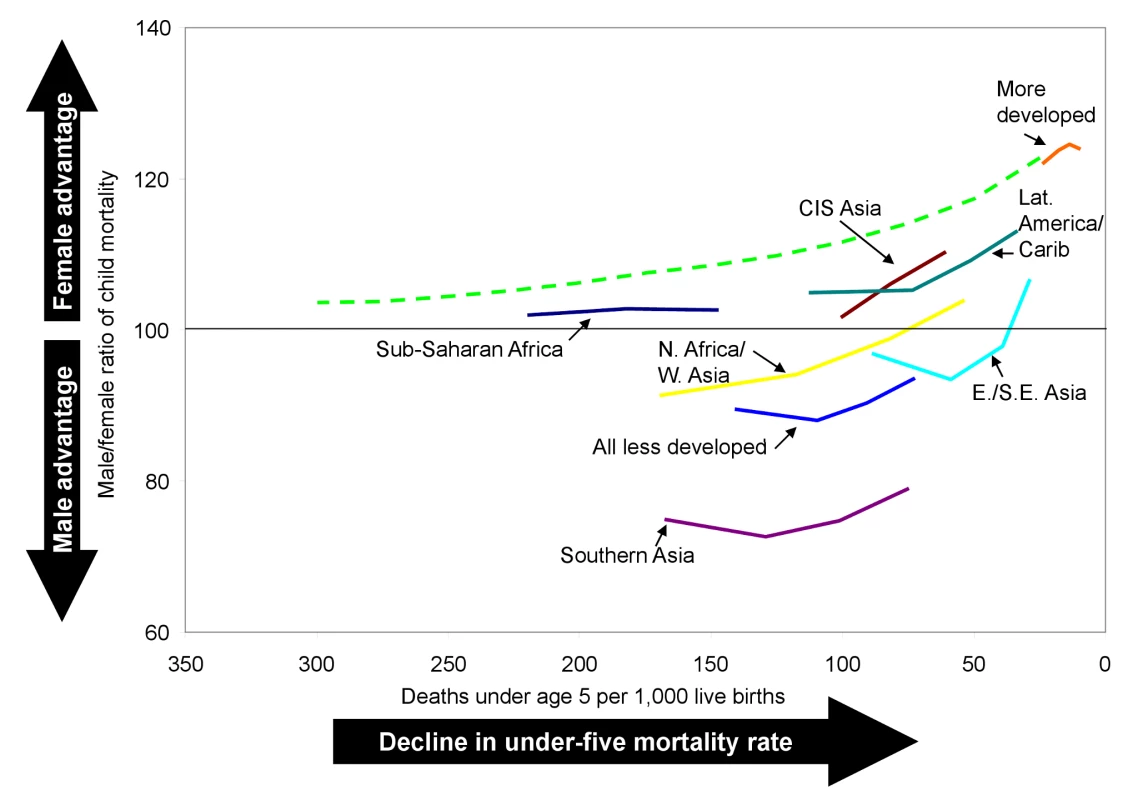
The rising regional average sex ratios of child mortality mask a number of cases where the estimates suggest continued or worsening female disadvantage in mortality at ages 1–4 y. While the case of India was highlighted above because of its weight in regional and world averages, there are many other countries where mortality in this age group was higher for girls than for boys in the 2000s. The countries where excess female child mortality was apparent in the 2000s are indicated in Figure 5. While countries with excess female mortality can be found in most regions of the developing world, there are notable concentrations in southern Asia and in the western and middle regions of sub-Saharan Africa, as well as several countries in northern Africa/western Asia. While data quality issues may affect the reliability of these estimates, countries with apparent female disadvantage merit further study to see if differential treatment is an issue.
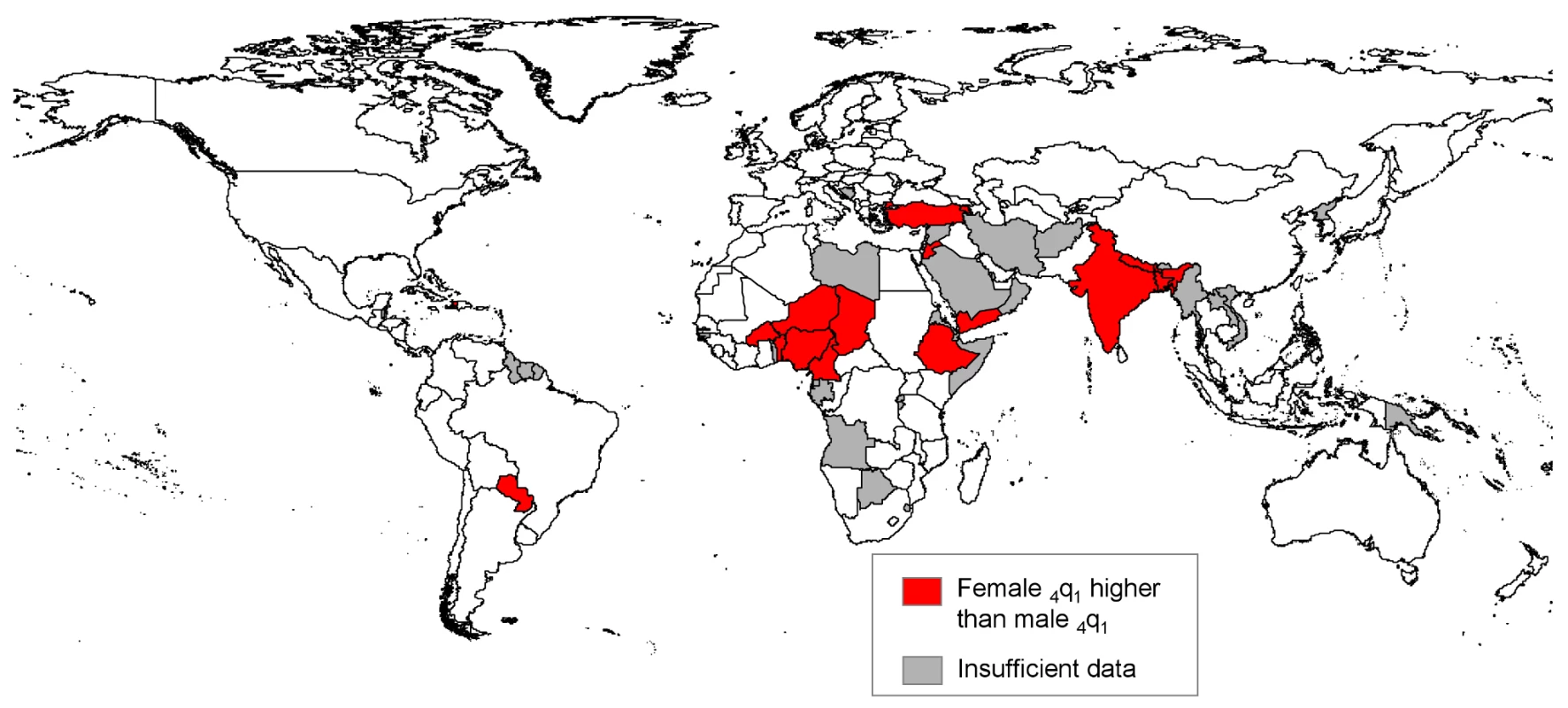
Among infants under age 1 y, girls continue to have the advantage in survival in all countries apart from China and India. However, the female survival advantage in infancy in most of the developing world is not as great as would be expected based on the historical experience of some developed countries at similar levels of mortality (Figure 6). It cannot be stated with certainty whether this finding is due to differences in the treatment of girls and boys, to factors such as differences in cause-of-death patterns or the rollout of medical interventions in different locations at a given level of mortality, or to issues with the quality of the data for some countries that affect the estimates in a systematic way.
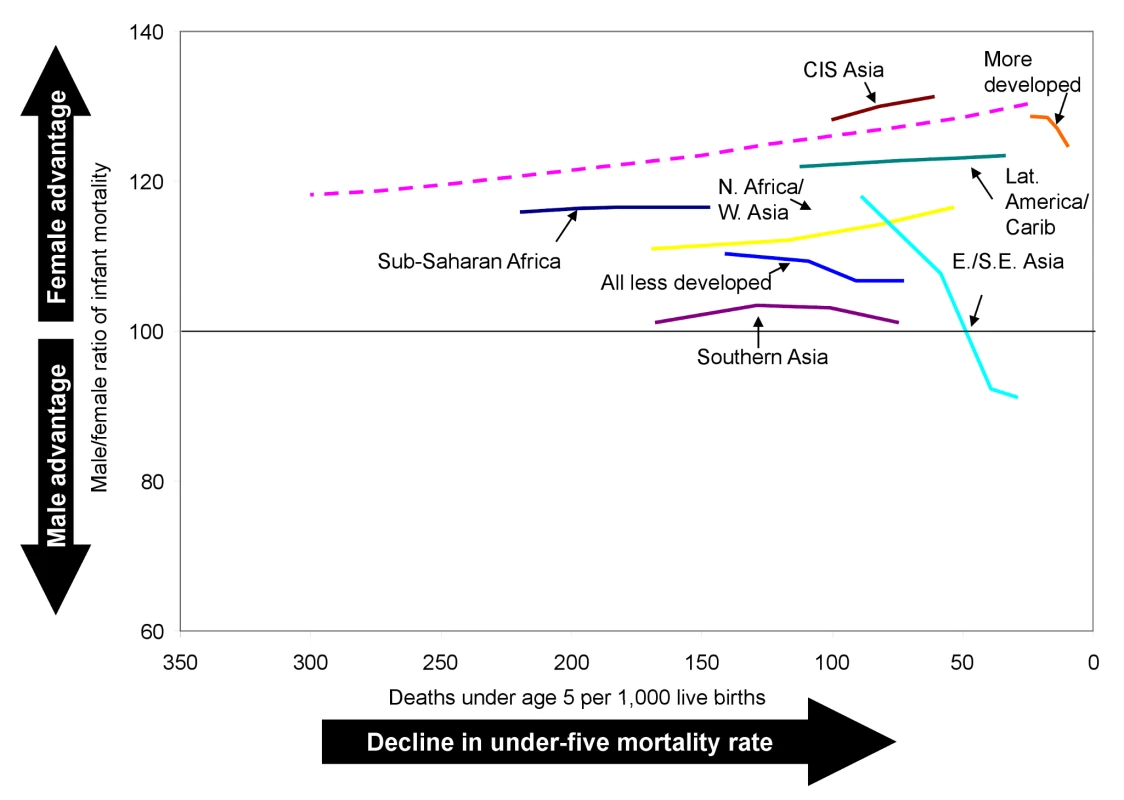
In the more developed regions, ratios of male to female infant mortality have been declining in recent decades (Tables 2 and 3; Figure 6), meaning that the male disadvantage in infant mortality is becoming smaller. This trend started in certain countries in the 1970s and has since spread to almost all of the developed countries and to a number of countries in the less developed regions that have relatively low levels of mortality. The change in trend may be attributable to improvements in neonatal care that have decreased deaths from prematurity and respiratory distress, causes that have a greater impact on male infants [38]. However, further study is required to confirm the causes of this trend.
Several countries had findings of unusually high sex ratios of infant mortality (greater than 130), suggesting a greater than expected degree of male disadvantage in survival. These countries, found in both more developed and less developed regions, include many of the European and Asian countries of the former Union of Soviet Socialist Republics (Figure 7). The high ratios could be due to lack of access to the advances in medical care that have led to declining sex ratios of infant mortality in most of the more developed regions, but again, more detailed examination of causes of infant deaths by age and sex is required.
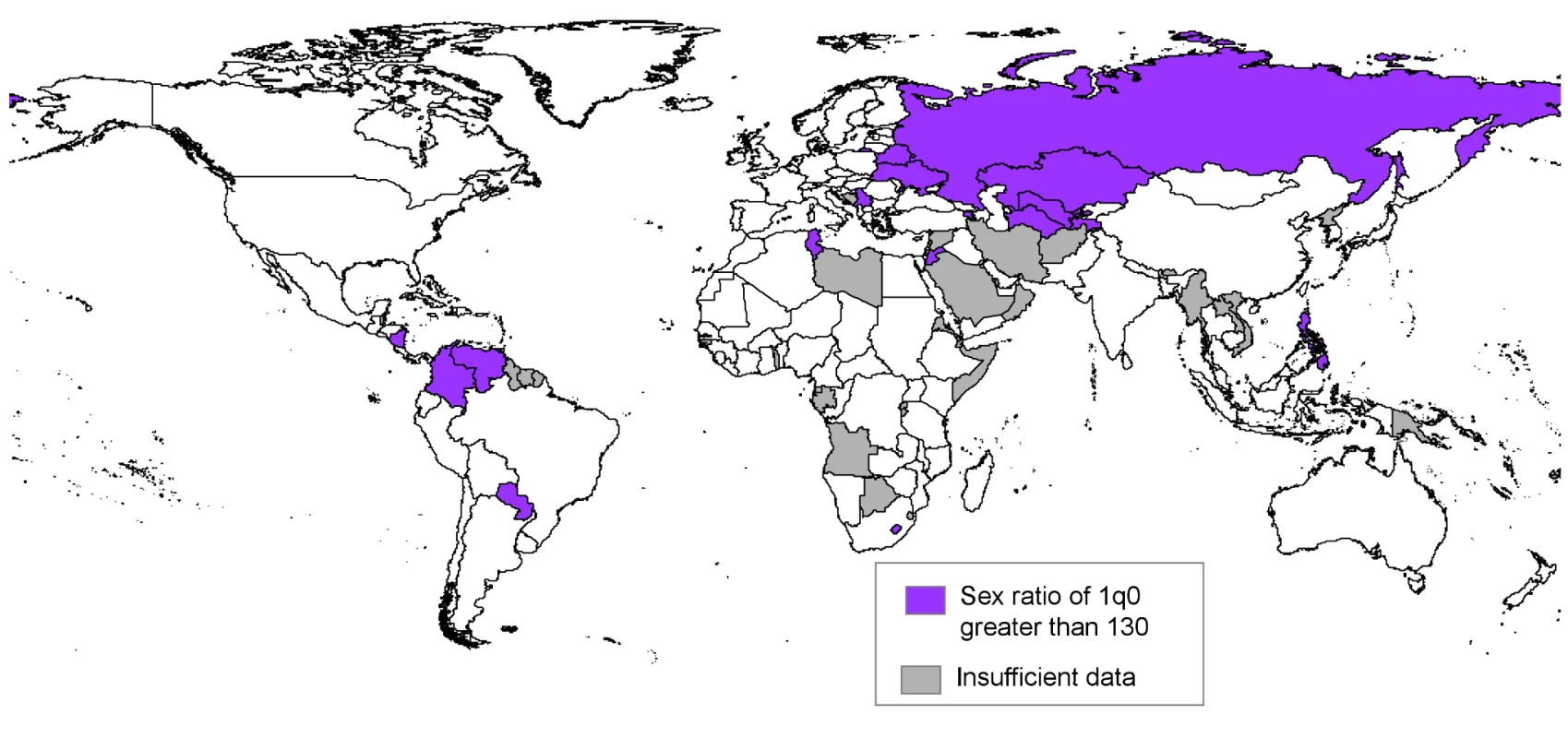
Discussion
Our estimates of long-term trends in the sex ratios of infant, child, and under-five mortality show that in the majority of countries in the less developed regions, the ratio of male to female under-five mortality has increased since the 1970s. This is due primarily to increases in the sex ratio of mortality at ages 1–4 y, while changes in the sex ratio of infant mortality have been smaller. There remain, however, a number of developing countries where girls have higher mortality than boys at ages 1–4 y, with concentrations in middle and western sub-Saharan Africa, northern Africa/western Asia, and southern Asia. Estimated infant mortality was higher for girls than for boys in only two countries, India and China. Meanwhile, in the more developed regions, a reversal of the historically rising trend in sex ratios of infant mortality has been observed as countries approach very low levels of mortality.
Estimates of under-five mortality levels are receiving intense focus as the world nears the 2015 target date for the Millennium Development Goals. The target for Millennium Development Goal 4 calls for reducing under-five mortality by two-thirds from its 1990 level, and efforts to strengthen child survival programs are intensifying. In many areas of the world, advances in survival appear to be accruing relatively equitably to girls and boys, in line with the changes in sex differentials expected given the changing cause-of-death patterns that accompany mortality decline. However, this is not universally the case. Findings of low or declining sex ratios of infant or child mortality in a number of countries that still have relatively high mortality may merit concern, as they suggest that girls in these countries may not be sharing fully in the recent improvements in survival. Further study is needed to confirm these findings, to identify why girls' relative survival may not be keeping pace in some countries, and to assess interactions with other barriers to care such as poverty or marginalization.
Studying Regions with Excess Female Mortality
Regions where concentrations of excess female child mortality were found would benefit from in-depth cross-national or sub-national studies of cause-specific mortality and mortality determinants by sex. Regions such as middle and western sub-Saharan Africa, northern Africa/western Asia, and southern Asia each have a number of countries with excess female child mortality, but also have countries where mortality is (or has become) higher for boys. Case studies from countries that have been successful in reducing inequalities in the survival of girls and boys—whether this was a conscious policy choice or an indirect outcome of generally expanded access to interventions—could provide useful insights and guidance for the planning of child health interventions and health system improvements.
The situation of girls in China and India, already well documented in the literature, merits continued study, as there is evidence that girls are not benefiting as much as boys from the mortality declines in these countries. The interaction of strong son preference and declining fertility has continued implications for the health and survival of girls in these countries. Both countries have implemented policies and programs intended to improve the status of girls and women as well as directly influence families' treatment of girls [2], but the available data, which refer most recently to 2005 for China and 2009 for India (Table S1), do not indicate significant change as yet in girls' relative survival to age 5 y, and trends in these countries should be reassessed as new data become available. In both countries, media and policy attention in recent years have concentrated largely on sex-selective abortion—that is, prenatal discrimination—but differences in postnatal treatment still have mortality consequences for large numbers of girls, particularly in India, where relatively high infant and child mortality rates mean that a significant number of excess deaths still occur.
The methods presented here have the benefit of producing comparable results for countries in a wide variety of data situations. They are valuable for making sense of noisy data from the often patchy collection of survey, census, and vital registration sources for many developing countries. Yet, they are also useful for analyzing sex differentials even in situations of good data quality and when mortality is low, because year-to-year fluctuations in the sex ratio of mortality can be substantial when numbers of infant and child deaths are low, as is the case even in very large countries with low mortality levels.
Limitations
The methods are subject to a number of limitations. Despite the use of robust regression methods to limit the influence of extreme data points that are due to sampling error, the nature of the data—which for many countries can be variable, sparse, or from sources for which data collection quality cannot be adequately assessed—does not permit strong conclusions. Particularly in the case of countries with only a few sources of data, addition of a new source may change the results substantially. Future work should aim to quantify the uncertainty of the estimates.
Another limitation, from an analytical standpoint, is that sex differentials in overall under-five mortality cannot be explained well without a nuanced understanding of mortality in the component age groups. The reliance on the sex ratio of 4q1 as an important indicator of sex differentials in this study is somewhat problematic. This ratio is calculated from sex-specific estimates of 4q1 that are derived after fitted trends in the sex ratios of infant and under-five mortality are used to disaggregate both-sexes estimates of infant and under-five mortality. Thus, the sex ratio of 4q1 is sensitive both to the fitted sex ratios of infant and under-five mortality, and to the relative levels of both-sexes infant and under-five mortality used as inputs. However, in cases where direct data on 4q1 by sex were available for comparison, the derived trends in the sex ratio of 4q1 were generally consistent with the empirical trends.
The estimates derived here will be useful for incorporation into life tables for the estimation of mortality and population change from the 1970s until today. In this way, they represent an advance over earlier studies of sex differentials in child mortality. However, the usefulness of the fitted trends for the projection of sex differentials in individual countries may be limited, particularly in cases where the estimated increases or decreases are steep and such rapid change cannot sensibly be projected into the future.
Conclusions
The results obtained here could be a first step in developing a model based on the experience of countries with low mortality, or on regional trends, to blend with the estimates, for purposes of projection. Such a model will also be useful for countries with little or no information on which to base estimates of sex differentials in mortality. However, I believe there is merit in using country-specific data to the extent possible, especially if the intent is to have policy-relevant monitoring of sex differences in mortality. Models based strictly on levels of mortality or regional dummies could mask findings that should prompt further investigation, such as the different trends in sex differentials among countries within regions such as northern Africa/western Asia and western Africa.
Despite the limitations detailed above, the methods developed here may be useful for the international community. The methods can be easily implemented by researchers or national authorities working with standard registration or survey data in their own countries. Applied cross-nationally, the methods can advance understanding of the dynamics of childhood mortality by sex around the world.
Supporting Information
Zdroje
1. United Nations Secretariat (1998) Levels and trends of sex differentials in infant, child and under-five mortality. In: Too young to die: genes or gender? ST/ESA/SER.A/155. New York: United Nations. pp. 84–108.
2. United Nations Department of Economic and Social Affairs Population Division (2011) Sex differentials in childhood mortality. ST/ESA/SER.A/314. New York: United Nations.
3. HillK, YouD, InoueM, OestergaardMZ (2012) Child mortality estimation: accelerated progress in reducing global child mortality, 1990–2010. PLoS Med 9: e1011303 doi:10.1371/journal.pmed.1001303.
4. Waldron I (1998) Sex differences in infant and early childhood mortality: major causes of death and possible biological causes. In: Too young to die: genes or gender? ST/ESA/SER.A/155. New York: United Nations. pp. 64–83.
5. Garenne M (1982) Variations in the age pattern of infant and child mortality with special reference to a case study in Ngayokheme (rural Senegal) [PhD dissertation]. Philadelphia: Department of Demography, University of Pennsylvania.
6. GarenneM, LafonM (1998) Sexist diseases. Perspect Biol Med 41: 176–189.
7. OmranA (1971) The epidemiologic transition: a theory of the epidemiology of population change. Milbank Mem Fund Q 49: 509–538.
8. Tabutin D, Willems M (1998) Differential mortality by sex from birth to adolescence: the historical experience of the West (1750–1930). In: Too young to die: genes or gender? ST/ESA/SER.A/155. New York: United Nations. pp. 17–52.
9. HillK, UpchurchDM (1995) Gender differences in child health: evidence from the Demographic and Health Surveys. Popul Dev Rev 21: 127–151.
10. Tabutin D, Gourbin C, Beninguisse G (2007) Surmortalité et santé des petites filles en Afrique. Tendances des années 1970 aux années 1990. In: Locoh T, editor. Genre et sociétés en Afrique: implications pour le développement. Paris: Institut National d'Études Démographiques. pp. 137–170.
11. Mahy M (2003) Childhood mortality in the developing world: a review of evidence from the Demographic and Health Surveys. DHS Comparative Reports No. 4. Calverton (Maryland): ORC Macro.
12. BanisterJ (2004) Shortage of girls in China today. J Popul Res 21: 19–45.
13. Lee JZ, Feng W (1999) One quarter of humanity: Malthusian mythology and Chinese realities, 1700–2000. Cambridge (Massachusetts): Harvard University Press.
14. Li S, Wei Y, Jiang Q, Feldman MW (2007) Imbalanced sex ratio at birth and female child survival in China: issues and prospects. In: Attané I, Guilmoto CA, editors. Watering the neighbour's garden: the growing demographic female deficit in Asia. Paris: Committee for International Cooperation in National Research in Demography. pp. 25–47.
15. Li S, Zhu C (1999) Gender differences in child survival in rural China: a county study. Paper No. 0080. Xi'an (China): Xi'an Jiaotong University.
16. Das GuptaM, ChungW, LiS (2009) Evidence for an incipient decline in numbers of missing girls in China and India. Popul Dev Rev 35: 401–416.
17. Li S (2007) Imbalanced sex ratio at birth and comprehensive intervention in China. New York: United Nations Population Fund. Available: http://www.unfpa.org/gender/docs/studies/china.pdf. Accessed 6 December 2011.
18. Miller B (1997) The endangered sex: neglect of female children in rural north India. Delhi: Oxford University Press.
19. Arokiasamy P (2007) Sex ratio at birth and excess female child mortality in India: trends, differentials and regional patterns. In: Attané I, Guilmoto CA, editors. Watering the neighbour's garden: the growing demographic female deficit in Asia. Paris: Committee for International Cooperation in National Research in Demography. pp. 49–72.
20. BasuA (1993) How pervasive are sex differentials in childhood nutritional levels in south Asia? Soc Biol 40: 25–37.
21. Das GuptaM (1987) Selective discrimination against female children in rural Punjab, India. Popul Dev Rev 13: 77–100.
22. MishraV, RoyTK, RetherfordRD (2004) Sex differentials in childhood feeding, health care, and nutritional status in India. Popul Dev Rev 30: 269–295.
23. PandeRP (2003) Selective gender differences in childhood nutrition and immunization in rural India: the role of siblings. Demography 40: 395–418.
24. BorooahVK (2004) Gender bias among children in India in their diet and immunisation against disease. Soc Sci Med 58: 1719–1731.
25. OsterE (2009) Proximate sources of population sex imbalance in India. Demography 46: 325–359.
26. Rutstein SO, Rojas G (2006) Guide to DHS statistics. Calverton (Maryland): ORC Macro.
27. United Nations (1990) Step-by-step guide to the estimation of child mortality. Population Studies No. 107 New York: United Nations.
28. United Nations (1995) Mortality in childhood by sex: Africa [database]. POP/1B/DB/95/2. New York: United Nations.
29. United Nations (1996a) Mortality in childhood by sex: Asia [database]. POP/1B/DB/96/2. New York: United Nations.
30. United Nations (1996b) Mortality in childhood by sex: Latin America and the Caribbean [database]. POP/1B/DB/96/2. New York: United Nations.
31. Curtis SL (1995) Assessment of the quality of data used for direct estimation of infant and child mortality in DHS-II surveys 1995. Occasional Papers No. 3. Calverton (Maryland): Macro International.
32. Pandey A, Choe MK, Luther NY, Sahu D, Chand J (1998) Infant and child mortality in India. National Family Health Survey Subject Reports No. 11. Mumbai: International Institute for Population Sciences and East-West Center Program on Population.
33. United Nations Children's Fund, World Health Organization, World Bank, United Nations Population Division (2007) Levels and trends of child mortality in 2006. Estimates developed by the Inter-agency Group for Child Mortality Estimation. New York: United Nations Children's Fund.
34. Hill K, Pande R, Mahy M (1999) Trends in child mortality in the developing world: 1960 to 1996. New York: United Nations Children's Fund.
35. United Nations Department of Economic and Social Affairs Population Division (2011) World population prospects: the 2010 revision. New York: United Nations.
36. United Nations Inter-agency Group for Child Mortality Estimation (2011) Levels & trends in child mortality: report 2011. New York: United Nations Children's Fund.
37. United Nations Children's Fund (2012) Statistics by area: child survival and health [database]. Available: http://www.childinfo.org/mortality_tables.php Accessed 24 July 2012.
38. DrevenstedtGL, CrimminsEM, VasunilashornS, FinchCE (2008) The rise and fall of excess male infant mortality. Proc Natl Acad Sci U S A 105: 5016–5021.
Štítky
Interní lékařstvíČlánek vyšel v časopise
PLOS Medicine
2012 Číslo 8
- Příznivý vliv Armolipidu Plus na hladinu cholesterolu a zánětlivé parametry u pacientů s chronickým subklinickým zánětem
- Berberin: přírodní hypolipidemikum se slibnými výsledky
- Léčba bolesti u seniorů
- Flexofytol® – přírodní revoluce v boji proti osteoartróze kloubů
- Nutraceutikum Armolipid Plus podle klinických důkazů zlepšuje lipidový profil − metaanalýza
Nejčtenější v tomto čísle
- Feasibility, Yield, and Cost of Active Tuberculosis Case Finding Linked to a Mobile HIV Service in Cape Town, South Africa: A Cross-sectional Study
- Multidrug Resistant Pulmonary Tuberculosis Treatment Regimens and Patient Outcomes: An Individual Patient Data Meta-analysis of 9,153 Patients
- Child Mortality Estimation: A Global Overview of Infant and Child Mortality Age Patterns in Light of New Empirical Data
- What Is the Optimal First Line Antiretroviral Therapy in Resource-Limited Settings?



